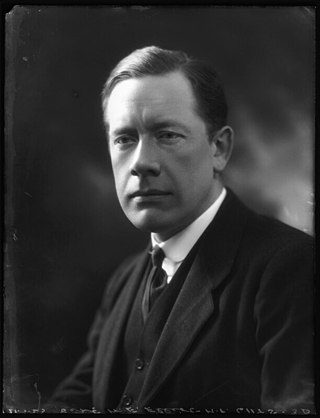A university constituency is a constituency, used in elections to a legislature, that represents the members of one or more universities rather than residents of a geographical area. These may or may not involve plural voting, in which voters are eligible to vote in or as part of this entity and their home area's geographical constituency.
The National Labour Organisation, also known simply as National Labour, was formed in 1931 by supporters of the National Government in Britain who had come from the Labour Party. Its leaders were Ramsay MacDonald (1931–1937) and his son Malcolm MacDonald (1937–1945).

Walter Elliot was a politician of Scotland's Unionist Party prominent in the interwar period. He was elected to the House of Commons of the United Kingdom in 1918, and besides an interval of months in 1923–24 and 1945–46, remained in parliament until his death. His Cabinet roles were as the Minister of Agriculture, Fisheries and Food in the National Government (1931–1935) of Ramsay MacDonald; as the Secretary of State for Scotland in the National Government (1935–1937) of Stanley Baldwin; and as Minister of Health in Neville Chamberlain's National Government (1937–1939) and the short-lived Chamberlain war ministry.
Parliamentary by-elections in the United Kingdom occur when a Member of Parliament (MP) vacates a House of Commons seat during the course of a parliament.
The 1929 Kilmarnock by-election was a by-election held on 27 September 1929 for the British House of Commons constituency of Kilmarnock in Ayrshire.
The 1935 Combined Scottish Universities by-election was a by-election held from 17 to 22 June 1935 for the Combined Scottish Universities, a university constituency of the British House of Commons.

The 1936 Combined Scottish Universities by-election was a by-election held from 27 to 31 January 1936 for the Combined Scottish Universities, a university constituency of the British House of Commons.
The 1946 Combined Scottish Universities by-election was a by-election held from 22 to 27 November 1946 for the Combined Scottish Universities, a university constituency of the British House of Commons.

The 1945 Combined Scottish Universities by-election was a by-election held from 9 to 13 April 1945 for the Combined Scottish Universities, a university constituency of the British House of Commons.
The 1927 Combined Scottish Universities by-election was a by-election held from 26 to 29 April 1927 for the Combined Scottish Universities, a university constituency of the British House of Commons.
The 1934 Combined Scottish Universities by-election was a by-election held from 7 to 12 March 1934 for the Combined Scottish Universities, a university constituency of the British House of Commons.
The 1941 Greenock by-election was a parliamentary by-election held on 10 July 1941 for the British House of Commons constituency of Greenock in Renfrewshire, Scotland. Hector McNeil was elected unopposed to succeed Robert Gibson.
The 1936 Greenock by-election was a by-election held on 26 November 1936 for the House of Commons constituency of Greenock in Renfrewshire, Scotland.
The 1933 Kilmarnock by-election was a by-election held on 2 November 1933 for the House of Commons constituency of Kilmarnock in Ayrshire.

The 1936 Ross and Cromarty by-election was a parliamentary by-election for the British House of Commons constituency of Ross and Cromarty held on 10 February 1936. The by-election was triggered when Sir Ian Macpherson, a Liberal National was given a peerage. This enabled cabinet minister Malcolm MacDonald to return to Parliament.
Independent progressive is a description used both in the United Kingdom and elsewhere to denote a political progressive who lacks a formal affiliation to a party.
The 1937 St Ives by-election was a by-election held in England on 30 June 1937 for the House of Commons constituency of St Ives in Cornwall.
The 1917 Aberdeen South by-election was a parliamentary by-election for the House of Commons constituency of Aberdeen South comprising the local government wards in the southern part of the city of Aberdeen. The by-election took place on 3 April 1917.
The 1937 Combined English Universities by-election was a parliamentary by-election for the British House of Commons dual member constituency of the Combined English Universities held on 22 March 1937.
The Popular Front in the United Kingdom attempted an alliance between political parties and individuals of the left and centre-left in the late 1930s to come together to challenge the appeasement policies of the National Government led by Neville Chamberlain.






